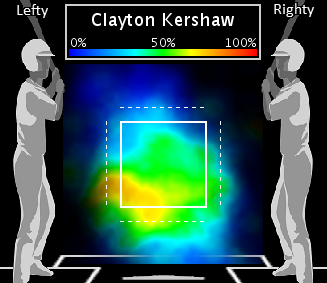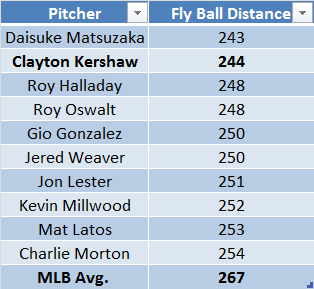Clayton Kershaw's $215 Million Curveball
 David Golebiewski |
David Golebiewski |  Monday, January 20, 2014 at 6:01AM
Monday, January 20, 2014 at 6:01AM
There are myriad reasons why Dodgers lefty Clayton Kershaw just earned a seven-year, $215 million contract extension, becoming the first player in history to pull in more than $30 million a season. Kershaw, 26 in March, boasts the fifth-best park-and-league-adjusted ERA (46 percent above average) ever for a starting pitcher during his first six seasons in the majors, trailing only Walter Johnson (164 ERA+), Mordecai Brown (158 ERA+), Smoky Joe Wood (152 ERA+) and Christy Mathewson (150 ERA+). He's a workhorse, having topped 200 innings pitched in each of the past four seasons, and he has fooled hitters like no other lefty (9.2 strikeouts per nine frames) this side of Randy Johnson (9.4 K/9) to start his career.
Yet for all of the breathtaking stats that Kershaw has compiled since making his debut at Chavez Ravine back in May of 2008, this one may be the most remarkable: he has thrown a total of 2,155 curveballs during the regular season, according to our Pitch F/X data, and exactly zero of those hooks have landed in the cheap seats. That's right -- Kershaw has never surrendered a regular-season homer on the pitch that earns him comparisons to Sandy Koufax. Batters have launched 1,945 home runs off curveballs dating back to '08, but nobody has gone deep against Public Enemy Number One.
What in the name of Vin Scully is going on here? How has Kershaw been so thoroughly dominant with his curveball, which has smothered hitters to the tune of a major league low .145 opponent slugging percentage from 2008-13? Here are three reasons why Kershaw's curve seemingly can't be taken deep.
Batters can't tell whether it's a ball or a strike -- or just don't think they can hit it
To go deep, you obviously have to swing the bat -- and opponents rarely do when Kershaw unleashes a curve. Batters have swung at just one-third of curveballs seen from Kershaw since '08, compared to the 40 percent major league average. Even when the pitch ends up being thrown in the strike zone, hitters pull the trigger less than half of the time (47 percent, compared to the 55 percent MLB average). Either batters can't discern whether it's over the plate in time to swing, or they figure it's futile to even try.
Hitters' swing rate by pitch location versus Kershaw's curveball, 2008-13

Kershaw's curve induces weak contact
When hitters do swing at Kershaw's curve, they often just pound the pitch into the infield grass or hit a weak fly ball. Kershaw has generated grounders 55.2 percent of the time that batters have put his curve in play, north of the 52 percent MLB average. Those who manage to loft the pitch into the air have won a moral victory, but little else. Batters have hit fly balls off Kershaw's curve an average of 244 feet -- second-lowest among all qualified starters dating back to 2008.
Lowest Average fly ball distance on curve balls put in play, 2008-2013 (min. 800 curveballs thrown)

Kershaw can add and subtract with his curve
L.A.'s ace has thrown his curveball at an average of 73.4 MPH during his career. But he can dial it way up (topping 82 MPH on the gun) or way, way down (he threw a 49 MPH yakker to Yasmani Grandal on September 9, 2012 -- Grandal didn't swing, of course). That might be part of the reason why hitters so rarely swing at Kershaw's curve -- it could be a power pitch, or it might arrive at home plate slower than a Prius traveling on Interstate 5.
Kershaw was wild with curveball when he first arrived in the bigs, throwing it for a strike less than half of the time, but he has gradually learned to control the pitch (57 percent strike rate last year) while adding precision to his power arsenal. His curve, like the rest of his game, has only gotten better. That's a scary proposition any hitter dreaming of finally going yard off the pitch.
 Contract Extensions,
Contract Extensions,  Curve ball,
Curve ball,  Dodgers | tagged
Dodgers | tagged  $215 million,
$215 million,  Clayton Kershaw,
Clayton Kershaw,  Los Angeles Dodgers,
Los Angeles Dodgers,  Sandy Koufax,
Sandy Koufax,  Vin Scully,
Vin Scully,  contract extension,
contract extension,  curveball
curveball
